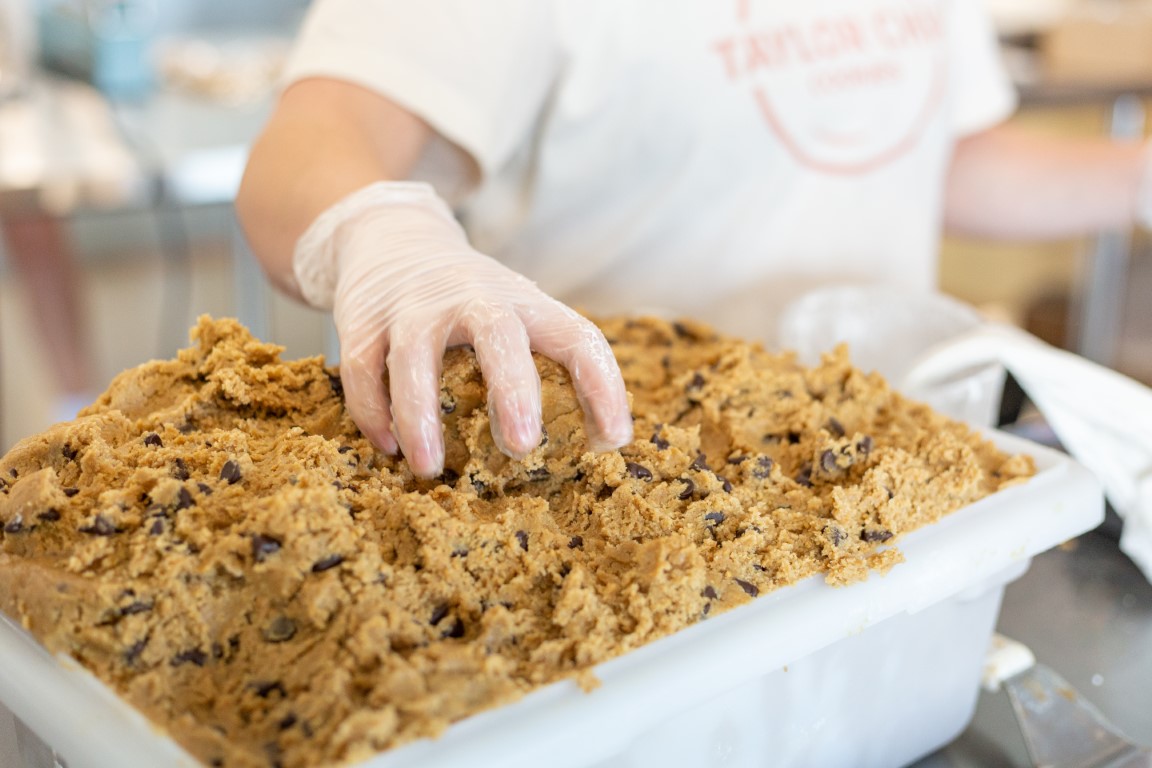You can certainly use cake flour for cookies to achieve a softer, more tender texture. Cake flour has a lower protein content than all-purpose flour, leading to less gluten formation and a finer, melt-in-your-mouth crumb. This makes it ideal for cookies requiring a light and airy consistency, like shortbread or sugar cookies. To guarantee the best results, measure accurately and mix the ingredients gently to prevent overworking the dough. Be mindful that cookie recipes might need slight adjustments, such as balancing baking powder or chilling dough, to achieve the desired texture and structure. Explore deeper into these adjustments for the best cookie results.
Key Takeaways
- Cake flour can be used for cookies, creating a tender and delicate texture.
- It has a lower protein content, reducing gluten development for softer cookies.
- Adjusting baking soda ensures even spreading when using cake flour.
- Cake flour is ideal for light, airy cookies like shortbread or sugar cookies.
- Mixing cake flour with all-purpose flour can provide more structure if desired.
What Is Cake Flour
Cake flour is a type of flour with a lower protein content compared to all-purpose flour, typically ranging between 7% and 9%, which makes it ideal for creating tender and soft baked goods. This lower protein level means less gluten formation, resulting in a finer, lighter texture that's particularly desirable in cakes and certain cookie recipes. Understanding these differences can help you choose the right flour for your baking needs, ensuring your cookies have the perfect balance of structure and softness.
Understanding Protein Content and Composition
Understanding the role of protein content in flour can transform your baking results. Cake flour, a specific flour type made from soft wheat flour, has a lower protein content compared to others. This low protein level reduces gluten formation, leading to a soft texture in your cookie recipes. When you use cake flour, you'll likely achieve a delicate texture, perfect for cookies that are tender and crumbly. If you prefer a chewy texture, you might want to experiment with combining different flour types. Using cake flour on your baking sheets can lead to cookies that hold their shape while remaining light and airy. Understanding these differences will help you tailor your recipes to create the cookies you love most.
How Cake Flour Differs From All-Purpose Flour
For many bakers, knowing the differences between cake flour and all-purpose flour is vital for perfecting their recipes. Cake flour is a low-protein flour with a fine consistency, resulting in a soft texture that's perfect for delicate pastries. Its lower gluten content helps create a tender crumb, unlike all-purpose flour, which has a higher protein level and yields a chewier texture. When you choose between these flours, consider the base texture you want in your baked goods. A flour mixture using all-purpose flour offers more structure, while cake flour provides a lighter feel. Additionally, the nutritional content may vary slightly, impacting your choice of ingredients based on dietary needs. Understanding these distinctions guarantees your cookies turn out just right.

Choose Your Own Delightfully Perfect Cookies.
With almost 30 flavors to choose from, you can make your box as unique as you are.
Effects of Cake Flour on Cookie Texture
When you use cake flour in your cookie recipes, you'll notice a distinct impact on the cookies' structure and tenderness. The lower protein content in cake flour means your cookies will be softer and more delicate, making it particularly beneficial for cookies like shortbread or sugar cookies that thrive on a tender crumb. By opting for cake flour, you're enhancing the texture of specific cookie types, resulting in a melt-in-your-mouth experience.
Impact on Cookie Structure and Tenderness
Cake flour can transform the texture of your cookies, making them tender and delicate. This flour type, known for its low protein content, impacts cookie structure by reducing gluten development, which results in tender cookies with soft centers. Unlike all-purpose flour, cake flour creates a finer crumb, preventing a bready texture and promoting a chewy texture instead. When you use cake flour, consider adjusting the baking powder to maintain the desired rise and texture. Adding vanilla extract can enhance the flavors, complementing the tender crumb with a subtle aroma. By choosing cake flour, you're ensuring a more refined cookie structure, ideal for those who prefer cookies with a soft, melt-in-your-mouth quality that stands apart from denser alternatives.
Benefits for Specific Cookie Types
Experimenting with different flours can greatly change the quality of your cookies, and cake flour is particularly suited for certain types. Cake flour biscuits, for instance, achieve a fluffy texture that melts in your mouth. When making soft chocolate chip cookies, using cake flour can create a cake-like texture with chewy centers, resulting in the perfect chocolate chip cookies that rival bakery cookie recipes. The lower protein content in cake flour influences the cookie dough, leading to cakey cookies with a tender, delicate crumb. This flour is ideal for those who prefer a soft mouth texture rather than a crisp or crunchy bite. By incorporating cake flour, your cookies can achieve a light, airy consistency that enhances both flavor and texture.
Best Practices for Baking Cookies With Cake Flour
When baking cookies with cake flour, start by adjusting your recipe to account for the flour's lower protein content, which may require less liquid or additional binding agents. Make sure to measure your ingredients accurately, using the spoon and level method for the flour, and mix them gently to avoid overworking the dough and affecting the texture. Cake flour is best suited for soft, tender cookies like sugar cookies or snickerdoodles, where its fine consistency contributes to a delicate crumb.
Recipe Modification Guidelines
Opting to use cake flour for your cookies can transform their texture, resulting in a tender and soft bite. To achieve the best results, consider these guidelines when modifying your cookie recipe:
-
Flour Substitution: Replace all-purpose flour with cake flour or pastry flour for a chewier texture. If you prefer unbleached flour, guarantee you adjust the baking temperature slightly.
-
Baking Additives: Incorporate a teaspoon of baking soda to help your cookie dough balls spread evenly, resulting in crisp edges.
-
Fat Content: Use butter for its rich flavor, but be mindful of its water content as it can affect the overall texture.
-
Type of Cookies: For chocolate chip cookies, using cake flour can yield a softer cookie, enhancing the flavors and textures.
Proper Measuring and Mixing Techniques
Precision is key when measuring and mixing ingredients for cookies made with cake flour. Start by using the correct type of flour, as cake flour has a lighter texture compared to all-purpose flour. When measuring, use the spoon-and-level method: spoon the flour into the measuring cup and level it off with a knife to avoid packing it densely. This guarantees you get the right cup of flour for your recipe. If you're using homemade cake flour, combine your dry ingredients thoroughly before adding them to the mix. Proper mixing techniques are vital; mix until just combined to prevent overworking the dough. Shape your dough into even dough balls to guarantee consistent cookie baking on the cookie sheet.
Recommended Cookie Types for Cake Flour
Cake flour is a fantastic choice if you're aiming for cookies with a tender, delicate crumb. It works well in recipes where you want a cake-y center, such as a chewy chocolate chip cookie. This flour's lower protein content compared to bread flour makes it ideal for creating the perfect cookie texture. When using cake flour, consider incorporating natural flours for added flavor and texture. Here are some cookie types to try:
- Chocolate Chip Cookies: Use a chocolate chip cookie recipe with chocolate chunks for soft, cake-like cookies.
- Sugar Cookies: Cake flour helps achieve a tender bite on prepared trays.
- Snickerdoodles: Their soft centers benefit from cake flour.
- Shortbread Cookies: Perfect for making batches of cookies with a delicate crumb on cookie trays.
Troubleshooting and Tips
When using cake flour for cookies, you might encounter issues like cookies spreading too much or having a crumbly texture, which can be frustrating. To address these problems, consider adjusting the butter or sugar ratios, as cake flour has a lower protein content that affects the dough's structure. Additionally, chilling the dough before baking can help maintain shape, so try experimenting with these adjustments to achieve the perfect cookie consistency.
Common Issues When Baking With Cake Flour
Baking with cake flour can sometimes lead to unexpected results, but understanding common issues makes troubleshooting a breeze. One primary concern is that this type of flour can make your baked cookies flat or give them a chiffon-like texture due to its lower protein content. Here's what to watch for:
- Flat Cookies: Cake flour can cause your cookies to spread too much, leading to flat cookies.
- Crispy Edges, Chewy Centers: The cookie dough might yield crispy edges with overly chewy centers.
- Coarse Texture: Instead of a smooth texture, your cookies might turn out coarse, lacking the desired uniform consistency.
- Cornstarch Content: Cake flour contains cornstarch, which can affect the final texture and density of your cookies.
Expert Solutions and Recommendations
Understanding the challenges of baking with cake flour enables you to tackle them with confidence. Start by using a blend of cake and almond flour to enhance texture and flavor. This combination prevents your batch of cookie dough from becoming too crumbly. Consider reducing the amount of unsalted butter to control spread and achieve a firmer consistency. To intensify the chocolate chip cookie flavor, add a teaspoon salt, balancing the sweetness. Choose bleached flour from your favorite brands for a finer, more delicate crumb. When mixing, fold in chocolate chips gently to maintain their shape. These expert recommendations help you create delicious cookies with cake flour, ensuring a delightful baking experience and satisfying results every time.
Recipe Examples and Success Stories
When you switch to cake flour for your cookie recipes, you'll notice a notable difference in texture and taste, creating a softer and lighter bite that many bakers rave about. Popular recipes like chocolate chip and sugar cookies benefit greatly from this change, producing cookies that are more tender and melt in your mouth. Before using cake flour, cookies might have been dense or crumbly, but now, you can expect a delightful transformation that enhances your baking success stories.
Popular Cookie Recipes Using Cake Flour
Many bakers swear by cake flour for their cookie recipes, attributing its soft, fine texture to the creation of delectably tender cookies. To try this yourself, here's a popular chocolate chunk cookie recipe that uses cake flour:
- Ingredients: Mix 1 cup flour, ½ cup cake flour, ½ cup granulated sugar, a teaspoon vanilla extract, and cold butter in a food processor until smooth.
- Add-ins: Stir in semisweet chocolate chips to taste.
- Preparation: Roll the mixture into small balls of dough.
- Baking: Place each ball on a sheet with parchment paper, ensuring ample space between them. Bake until golden brown.
This recipe results in cookies that are soft inside with a lovely crumbly texture outside, a proof of the magic of cake flour.
Before and After Results
With cake flour in your baking arsenal, the transformation of your cookie recipes can be remarkable. Switching the base ingredient from all-purpose to cake flour can result in cookies that are lighter and more tender. By preparing the dough in advance, you allow flavors to meld and improve texture. A successful example is replacing part of the original recipe's flour with cake flour, while incorporating coconut flour to add a subtle nutty flavor.
When baking, watch as your cookies turn golden brown, thanks to the combination of white sugar and a touch of corn starch. This mix enhances the softness and chewiness that flour products like biscuit dough often lack. These small adjustments can enhance your cookies, showcasing the versatility of cake flour in baking.
Our Journey from Home Bakers to Cookie Experts
At Taylor Chip, our expertise in cookie baking comes from years of dedicated experimentation and hands-on experience. Since 2015, we've devoted countless hours to perfecting the art of cookie making, testing various flour types, ingredients, and techniques to achieve the perfect texture and taste. What started as a shared passion during our date nights transformed into a deep understanding of cookie science and baking chemistry.
Our journey to mastering cookies has given us unique insights into the nuances of different flour types and their effects on cookie texture. Through extensive trial and error, we've discovered how ingredients like cake flour can transform an ordinary cookie into something extraordinary.
We've tested hundreds of variations in our quest to create the perfect cookie, experimenting with different protein contents, moisture levels, and mixing techniques. This hands-on experience allows us to share not just theoretical knowledge, but practical, tested advice that we know works in real-world baking situations.
Frequently Asked Questions
How Does Cake Flour Differ From All-Purpose Flour in Protein Content?
Cake flour differs from all-purpose flour because it has a lower protein content, usually around 7-9%, compared to 10-12%. This difference affects gluten formation, making cake flour ideal for tender baked goods.
Can I Substitute Cake Flour for All-Purpose Flour in Other Baked Goods?
You can substitute cake flour for all-purpose flour in other baked goods, but it might change the texture. Cake flour's lower protein content results in a softer, more tender product, so adjust recipes and expectations accordingly.
What Brands of Cake Flour Are Most Recommended for Cookie Baking?
You're curious about the best cake flour brands for baking cookies. King Arthur, Swan's Down, and Bob's Red Mill often receive high praise. They're known for their consistency and quality, making your cookies soft and delightful.
Are There Any Gluten-Free Cake Flour Alternatives for Cookies?
You're looking for gluten-free cake flour alternatives for cookies. Consider using almond or coconut flour for a softer texture. They're popular choices among bakers aiming to avoid gluten while still achieving delicious, tender cookies.
How Should Cake Flour Be Stored to Maintain Its Freshness?
Store cake flour in an airtight container to keep it fresh. Place it in a cool, dry spot away from sunlight. You can even refrigerate or freeze it for extended freshness, just make certain it's sealed properly.
Conclusion
To summarize, using cake flour for cookies can yield soft, tender results, distinct from those made with all-purpose flour. By understanding cake flour's low protein content, you can adjust recipes to achieve your desired texture. Follow best practices, like precise measuring and careful mixing, to guarantee success. Troubleshoot common issues by considering dough consistency and baking time. With these tips, you can confidently experiment with cake flour, creating delicious cookies that highlight your baking skills.









